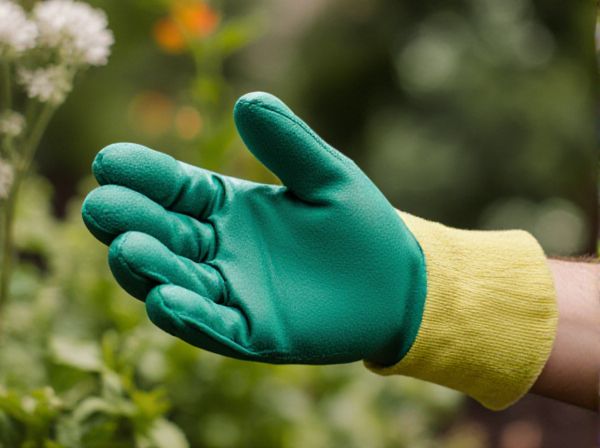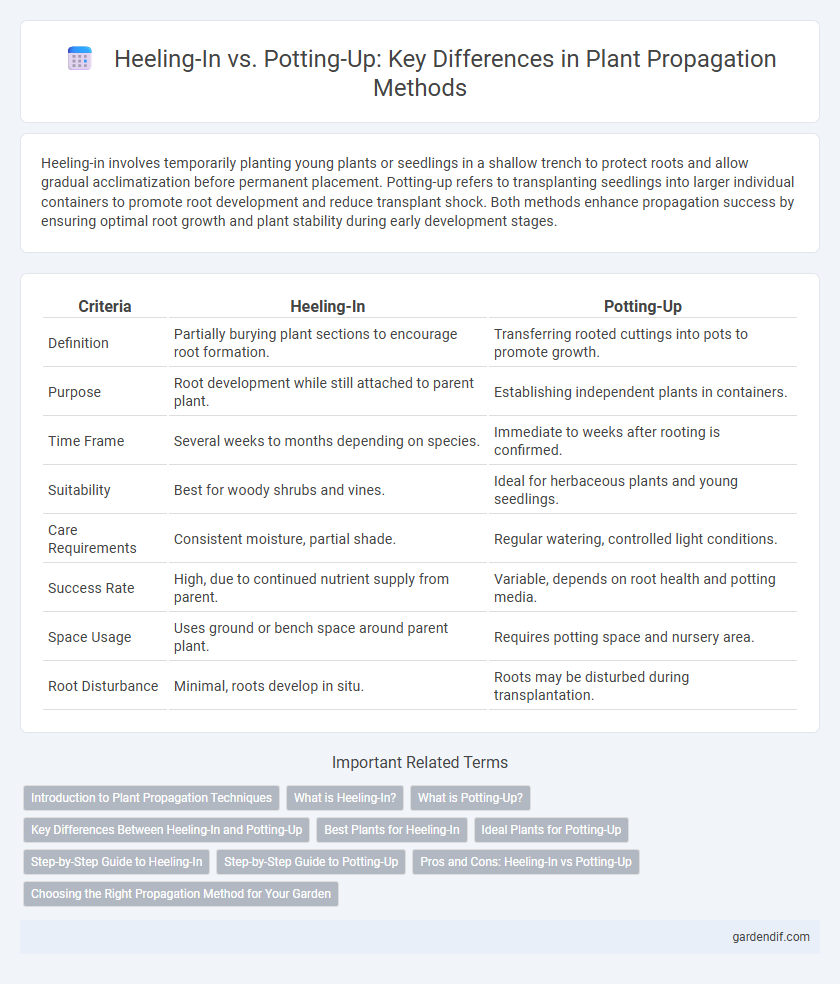
Heeling-In vs Potting-Up Illustration
Heeling-in involves temporarily planting young plants or seedlings in a shallow trench to protect roots and allow gradual acclimatization before permanent placement. Potting-up refers to transplanting seedlings into larger individual containers to promote root development and reduce transplant shock. Both methods enhance propagation success by ensuring optimal root growth and plant stability during early development stages.
Table of Comparison
| Criteria | Heeling-In | Potting-Up |
|---|---|---|
| Definition | Partially burying plant sections to encourage root formation. | Transferring rooted cuttings into pots to promote growth. |
| Purpose | Root development while still attached to parent plant. | Establishing independent plants in containers. |
| Time Frame | Several weeks to months depending on species. | Immediate to weeks after rooting is confirmed. |
| Suitability | Best for woody shrubs and vines. | Ideal for herbaceous plants and young seedlings. |
| Care Requirements | Consistent moisture, partial shade. | Regular watering, controlled light conditions. |
| Success Rate | High, due to continued nutrient supply from parent. | Variable, depends on root health and potting media. |
| Space Usage | Uses ground or bench space around parent plant. | Requires potting space and nursery area. |
| Root Disturbance | Minimal, roots develop in situ. | Roots may be disturbed during transplantation. |
Introduction to Plant Propagation Techniques
Heeling-in and potting-up are fundamental plant propagation techniques used to ensure healthy root development and successful transplantation. Heeling-in involves temporarily burying plants in soil to protect roots and maintain moisture during transport or short-term storage. Potting-up refers to transplanting seedlings or cuttings into larger pots to encourage robust growth before final planting.
What is Heeling-In?
Heeling-In is a propagation technique where a young plant or cutting is temporarily planted at an angle in a trench or hole, allowing its roots to establish gradually before being transferred to a permanent location. This method helps maintain root moisture and reduces transplant shock by providing a controlled environment for root development. Heeling-In is commonly used for seedlings, bare-root plants, or cuttings that require temporary shelter before potting-up or final planting.
What is Potting-Up?
Potting-up is a propagation technique where a rooted cutting or young plant is transferred from a smaller container to a larger pot to provide more space for root development and growth. This method supports healthier root systems by preventing overcrowding and ensuring adequate nutrients and moisture availability. Potting-up promotes stronger plants ready for eventual transplanting or continued indoor cultivation.
Key Differences Between Heeling-In and Potting-Up
Heeling-in involves temporarily placing a plant's root ball in a trench or container filled with soil or water to keep roots moist before final planting, ensuring minimal transplant shock. Potting-up refers to transferring a plant into a larger pot to allow for continued root growth and development without immediate outdoor planting. Key differences include heeling-in's temporary, protective nature versus potting-up's focus on growth promotion and pot size adjustment.
Best Plants for Heeling-In
Heeling-in is an ideal propagation method for plants with delicate root systems, such as azaleas, rhododendrons, and camellias, which require temporary moisture and protection before potting up. These species benefit from the hooded environment of heeling-in, which maintains consistent humidity and prevents root desiccation. Plants prone to root damage or transplant shock respond better to heeling-in compared to direct potting up, ensuring higher survival rates during transitional growth phases.
Ideal Plants for Potting-Up
Ideal plants for potting-up include young seedlings and cuttings with established root systems that benefit from increased soil volume and nutrients to promote healthy growth. Species like tomatoes, peppers, and herbs such as basil thrive when transferred to larger pots, allowing their roots to expand without disturbance. Choosing plants with vigorous root development ensures successful transplantation and reduces the risk of transplant shock during potting-up.
Step-by-Step Guide to Heeling-In
Heeling-in involves partially burying the root ball of a plant in moist soil to acclimate it before full transplantation, enhancing root stability and hydration. Begin by selecting a shaded, protected area and digging a trench deep enough to cover the root ball halfway, ensuring consistent moisture throughout the process. Maintain optimal moisture levels and monitor for signs of stress over several days before fully potting up, ensuring successful adaptation and growth.
Step-by-Step Guide to Potting-Up
Potting-up involves selecting a slightly larger pot to accommodate root growth and ensuring proper drainage by adding a layer of gravel or broken pottery at the base. Gently place the plant into the new pot, filling around the roots with fresh, nutrient-rich potting mix and pressing lightly to eliminate air pockets. Water thoroughly after potting to help settle the soil and support initial root establishment in the new environment.
Pros and Cons: Heeling-In vs Potting-Up
Heeling-in offers the advantage of rapid plant propagation by temporarily situating cuttings in moist soil, which encourages root initiation with minimal equipment, but it may expose cuttings to environmental stress and requires careful monitoring to prevent drying out or fungal infections. Potting-up enhances plant stability and root development by transferring rooted cuttings into individual pots with controlled soil conditions, reducing the risk of transplant shock and facilitating better nutrient management, though it is more time-consuming and resource-intensive than heeling-in. Choosing between heeling-in and potting-up depends on propagation goals, available resources, and the specific plant species' tolerance to handling and environmental factors.
Choosing the Right Propagation Method for Your Garden
Heeling-in is ideal for temporarily protecting bare-root plants by partially burying their roots to maintain moisture and prevent damage during transport or short-term storage. Potting-up suits gardeners aiming to gradually nurture young seedlings or cuttings in controlled soil environments, promoting root development before final transplantation. Selecting the right propagation method depends on plant type, growth stage, and intended timing for planting, ensuring optimal survival and growth in your garden.
Heeling-In vs Potting-Up Infographic

 gardendif.com
gardendif.com